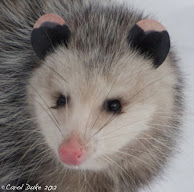 While waiting for a dear friend to arrive for a walk and then visit to a nearby waterfall, I took a few shots of some of the Blue Bird and Cedar Wax Wing activity right outside my barn studio. Just now as I write this I can see a male Cardinal picking at a rose hip in one of my Rosa Rugosas and there are flocks of Juncos and muted Goldfinches flitting about taking my head with them back and forth and up and down. There are hundreds of birds in the gardens most every day. Though I have no feeders, they find plenty to snack on.
While waiting for a dear friend to arrive for a walk and then visit to a nearby waterfall, I took a few shots of some of the Blue Bird and Cedar Wax Wing activity right outside my barn studio. Just now as I write this I can see a male Cardinal picking at a rose hip in one of my Rosa Rugosas and there are flocks of Juncos and muted Goldfinches flitting about taking my head with them back and forth and up and down. There are hundreds of birds in the gardens most every day. Though I have no feeders, they find plenty to snack on. Cedar Waxwings love the English Hawthorn berries and all the other flocks dine on seeds, while the Bluebirds seem mostly interested in checking out the rustic housing. There were several pairs eyeing and flying to and from this particular house this day. They do not require anything fancy and I like how this dwelling blends right into the landscape. You can see some of the earlier goings on with the Blue Birds and this house here and here. You will see more than just the Blue Birds when you click on the links. Just keep scrolling, scrolling, scrolling and I promise you will not be disappointed. You will have to scroll thru this one too on the second link.
When Eva arrives we take a quick spin in the garden to see how the brush hog clearing is going. I eye a bit more blue . . . in a flower this time. Some little creature is munching on the last Myrtle flower. I would bet the Juncos will kick up a few leaves and find a tiny caterpillar or some other meaty morsel.
The golden yellow of the Crabapples, I do not recall the name of, is a mirror to the fluffy coat the Goldfinches wear late spring, summer and fall. Nature protects her creatures by having them molt at about the same time the leaves are forced to fall. This little Goldfinch is enjoying a meal of Anise Hyssop seeds. Perhaps the aroma of the seeds will give the bird a fresher breath. A Junco is looking on and will join in on the seed nosh.
Afternoon light is so lovely . . . giving a brilliant glow to the gray and white birches. There is music in the grasses as we walk down towards the lower garden to see my neighbor busy with his tractor. Kris is a wizard with his machine and I so appreciate his vision merging with mine own in keeping the land open. What he is not able to do with his tractor, I must go in and cut with my hand machines. It is a great deal of hard work on this hillside. A good bit of pruning will occur over the winter months too.
The mowing occurs after all the leaves have fallen making it easier for Kris to see, as there are rocks everywhere. If it were not for the many birds nesting here I would do this twice a year and have more of a chance of winning the on going battle with mostly sumac, briars and vines. The forest too is trying to reclaim the open areas. Who is this little fellow?
As we were heading back up and to the car, this Cedar Waxwing greeted us with a bit of a wary eye . . . perhaps the confusion with the tractor had him wondering what was going on. It is rare for one to sit so close and let me capture its portrait this way. We are off and seven minutes down the country road by car we come to one of my favorite waterfalls 'Chapel Falls'. I will share the falls in a future post. For today a sneak preview with peace shadows and a birthday wish for my dear friend. Many Many Happy Returns Eva.
The sun settling towards the west painted our shadow silhouettes . . . upon the tree . . . a bit like graffiti . . . only it faded very quickly and left no mark upon the bark. Here is a turtle rock for you . . . since your imagination gave it that form. May your foundation be as solid and your beauty constant.
After lingering a good long while within the sounds and sprays of positive ions we headed back to Flower Hill Farm to see the open land. I so long for an orchard in this south facing field, mostly going down the slope . . . but that will take mowing a few times a year to kill all the saplings that grow back each spring. Maybe one day I will just do it! I must dash off now, grab my camera and try to catch the Red-tailed Hawk who is perched in the English Hawthorn!
























































































































































































